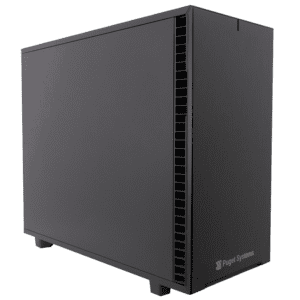This is a follow up post to “Quad RTX3090 GPU Wattage Limited “MaxQ” TensorFlow Performance”. This post will show you a way to have GPU power limits set automatically at boot by using a simple script and a systemd service Unit file.
Quad RTX3090 GPU Wattage Limited “MaxQ” TensorFlow Performance
Can you run 4 RTX3090’s in a system under heavy compute load? Yes, by using nvidia-smi I was able to reduce the power limit on 4 GPUs from 350W to 280W and achieve over 95% of maximum performance. The total power load “at the wall” was reasonable for a single power supply and a modest US residential 110V, 15A power line.
RTX3070 (and RTX3090 refresh) TensorFlow and NAMD Performance on Linux (Preliminary)
The GeForce RTX3070 has been released.
The RTX3070 is loaded with 8GB of memory making it less suited for compute task than the 3080 and 3090 GPUs. we have some preliminary results for TensorFlow, NAMD and HPCG.
RTX3090 TensorFlow, NAMD and HPCG Performance on Linux (Preliminary)
The second new NVIDIA RTX30 series card, the GeForce RTX3090 has been released.
The RTX3090 is loaded with 24GB of memory making it a good replacement for the RTX Titan… at significantly less cost! The performance for Machine Learning and Molecular Dynamics on the RTX3090 is quite good, as expected.
RTX3080 TensorFlow and NAMD Performance on Linux (Preliminary)
The much anticipated NVIDIA GeForce RTX3080 has been released. How good is it with TensorFlow for machine learning? How about molecular dynamics with NAMD? I’ve got some preliminary numbers for you!
2 x RTX2070 Super with NVLINK TensorFlow Performance Comparison
This is a short post showing a performance comparison with the RTX2070 Super and several GPU configurations from recent testing. The comparison is with TensorFlow running a ResNet-50 and Big-LSTM benchmark.
How to Install TensorFlow with GPU Support on Windows 10 (Without Installing CUDA) UPDATED!
This post is the needed update to a post I wrote nearly a year ago (June 2018) with essentially the same title. This time I have presented more details in an effort to prevent many of the “gotchas” that some people had with the old guide. This is a detailed guide for getting the latest TensorFlow working with GPU acceleration without needing to do a CUDA install.
TensorFlow Performance with 1-4 GPUs — RTX Titan, 2080Ti, 2080, 2070, GTX 1660Ti, 1070, 1080Ti, and Titan V
I have updated my TensorFlow performance testing. This post contains up-to-date versions of all of my testing software and includes results for 1 to 4 RTX and GTX GPU’s. It gives a good comparative overview of most of the GPU’s that are useful in a workstation intended for machine learning and AI development work.
RTX 2080Ti with NVLINK – TensorFlow Performance (Includes Comparison with GTX 1080Ti, RTX 2070, 2080, 2080Ti and Titan V)
More Machine Learning testing with TensorFlow on the NVIDIA RTX GPU’s. This post adds dual RTX 2080 Ti with NVLINK and the RTX 2070 along with the other testing I’ve recently done. Performance in TensorFlow with 2 RTX 2080 Ti’s is very good! Also, the NVLINK bridge with 2 RTX 2080 Ti’s gives a bidirectional bandwidth of nearly 100 GB/sec!
NVLINK on RTX 2080 TensorFlow and Peer-to-Peer Performance with Linux
NVLINK is one of the more interesting features of NVIDIA’s new RTX GPU’s. In this post I’ll take a look at the performance of NVLINK between 2 RTX 2080 GPU’s along with a comparison against single GPU I’ve recently done. The testing will be a simple look at the raw peer-to-peer data transfer performance and a couple of TensorFlow job runs with and without NVLINK.
